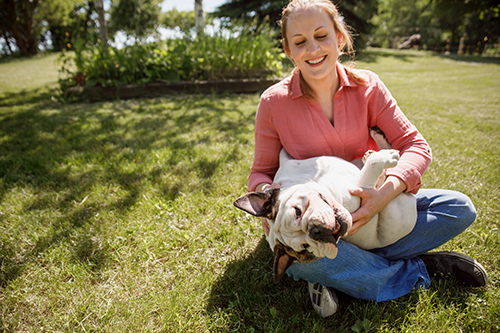Pets And Sunburn Know The Risks

Summer is here and we all want to be outside with our pets. Whether it is the beach, the park or hiking in the mountains. In the summertime, even though the Earth is more distant from the sun, the intensity of the skin tanning/burning ultraviolet light (UV) is much greater than other times of the year. This is due the more direct angle of the UV rays hitting our planet. During the summer we are likely to get a sunburn faster from these ultraviolet rays. However, many of us are unaware that our pets are at risk for sunburn as well. While they are covered with hair, this does not always protect from them the sun’s damaging UV rays. Repeated sunburns in pets can lead to malignant skin cancers such as squamous cell carcinoma, malignant melanoma and hemangioma/hemangiosarcoma.
The most common skin areas for pets to get sun burns are places where there is little or no hair: nose, ears and ear tips, belly, groin, eyelid margins and the hairless areas of the lips. Pets that are more susceptible include breeds with light or white short body hair (white Boxers, Dalmatians, white Bull Terriers, Whippets, Greyhounds, Weimaraner’s and white cats), thinly haired ears (Dachshunds, Sphinx cats) and pets with illnesses causing thin hair coats (skin infection, endocrine disease). Dogs and matted outdoor cats that get the summer buzz cut as a way of staying cool are at high risk as their skin sees sunlight for the first time. Be aware that any pet, with enough exposure, can get a sunburn.
Consider the following suggestions to protect your pet against sunburn:
- Shade: Always provide access to shade, whether it be an umbrella or canopy at the beach or pool, a shady tree at the park or a sun blocking top for an outdoor kennel.
- Early and Late: Consider walking or playing with your pet in the early morning or later in the afternoon or evening when the sun is less intense. Avoid peak sun from 10 a.m. to 4 p.m.
- Grooming: Try to avoid the summer buzz but. If your pet needs to be groomed, ask the groomer to leave the hair a little longer than normal to protect the skin.
- Protect, Protect, Protect: Use a pet friendly sunscreen on the most vulnerable areas (nose, ears, belly and groin). Remember that UV can be reflected off the sand, cement or pool water. Pet friendly sunscreens are available online and in some pet stores. UV blocking clothing for pets is also available.
If you use sunscreen on your pet, it’s important not to use human sunscreen. Zinc oxide containing sunscreen can cause hemolytic anemia if ingested. In addition, avoid sunscreens containing para-aminobenzoic acid (PABA) as it can be toxic if ingested. Cats also need to avoid sunscreen containing octisalate or acetylsalicylate, an aspirin like substance that can be toxic if ingested. In fact, there are no sunscreens specifically formulated and safe for cats. The best option is to use a product for dogs called Snout Soother. It is not specifically a sunscreen, but the ingredients are safe for cats and it is an SPF9 product.
Sunburn in pets looks like sunburn in people. The skin will be red, warm and tender to the touch. The skin may also be dry, cracked and itchy. The pet may tend to hide or cower when touched. In some cases, there may be curling to the edges of the ears. If you suspect your pet has a sunburn, a cool compress may help if he will allow you to apply it to the skin. Aloe Vera gel or the sap from an Aloe Vera plant can be soothing. Witch hazel can also be used. Once the acute nature of the burn is gone, vitamin E oil can be used to decrease scaring. If you have any concerns or are uncertain, contact your veterinarian.
